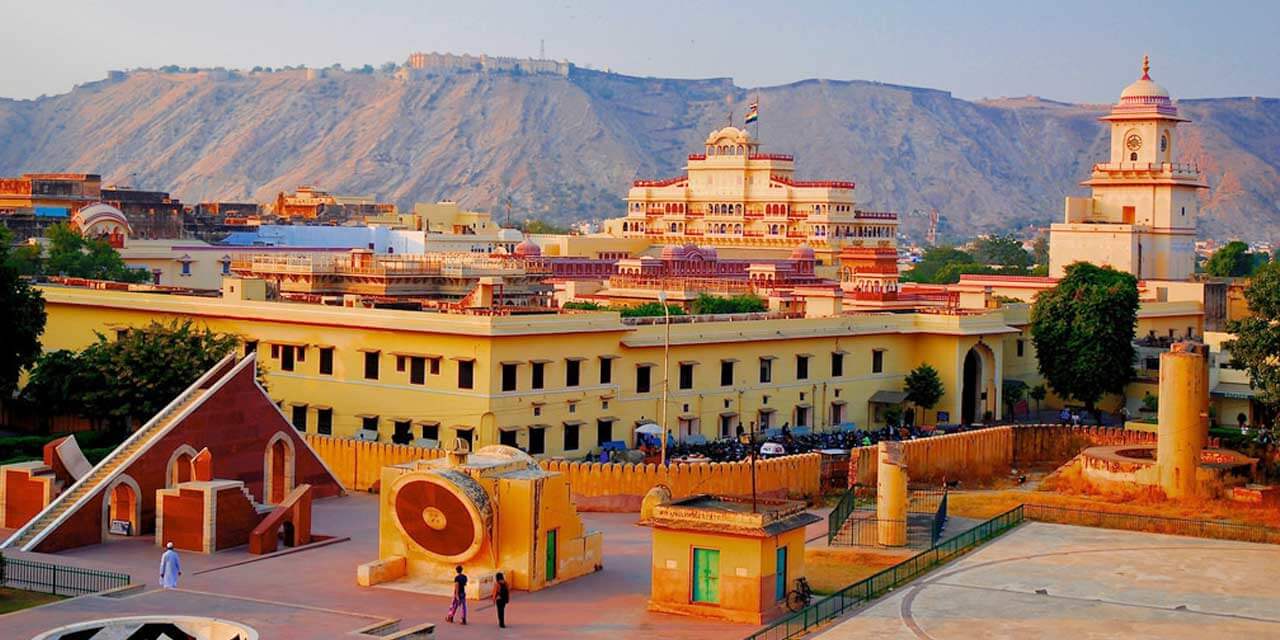Jantar Mantar Jaipur Entry Fee
- 50 per person for Indians
- 15 per person for Indian Students
- 200 per person for Foreign Tourists
- 100 per person for Foreign Students
Jantar Mantar Jaipur Phone
0141 261 0494
Rating:  | 4/5 stars
| 4/5 stars
Based on total 12 reviews
Jantar Mantar Jaipur Address: Gangori Bazaar, J.D.A. Market, Kanwar Nagar, Jaipur, Rajasthan, 302002, India
Your Guide to an Astronomical Delight…
Jantar Mantar in Jaipur has captured the essence of many a wanderlust over the years. An open-air astronomical observatory, this UNESCO World Heritage Site, is one of the rare and timeless places of attraction in Jaipur, and the world.
With an illuminating history that predates modern civilization, this observatory was far ahead of its time and showcased the ancient ways of reading stars and skies.
History of Jantar Mantar
A place that speaks for itself…
Built in the early 18th century by Maharaja Sawai Jai Singh II, it is a conglomeration of fixed stones and very large structures. Each has its specific usage. The main reason for it being built was because of the Maharaja’s fascination with celestial objects and movement of different bodies in the sky.
Jantar Mantar in Jaipur has 19 large instruments with very specific purposes, the most popular and prominent one being- the Samrat Yantra. It is considered to be largest sundial of the country.
The complete construction of this magnificent monument was concluded in 1734. The main highlight of the instruments is to view observation of celestial objects with the naked eye. It is based on the Ptolemaic positional astronomy that has shared similarities amongst many civilizations over the years.
#Trivia: It had attracted scientific minds from across the globe to study the positions of celestial objects and gave rise to widespread scientific deductions such as cosmology.
Image Gallery of Jantar Mantar Jaipur, India
Architecture of Jantar Mantar
Through the hands of the artisan comes alive the magnificence of Jantar Mantar…
It is believed that the king employed the knowledge and skill of 23 astronomers of Jaipur to bring his dream to life. The observatory has experienced many hurdles during its time and has emerged to be an architectural masterpiece of the country.
The monument itself is made of marble and stone, made locally. Each instrument in this observatory involved detailed planning and carries an astronomical scale. This humongous structure is spread over 18000 sq.mtrs. The tablets, bronze tablets and mortar were the most prominent materials used to construct the structure, making it strong and sturdy even today.
Today, the Jantar Mantar in Jaipur is maintained by the Archaeological Sites and Monuments, Rajasthan, since 1961.
Importance and highlights of the Jantar Mantar, Jaipur
An open-air observatory that has seen many a ruler trying to revive it to its former glory, but none could do so as well as Maharaja Sawai Jai Singh II.
#Trivia- Jantra means ‘instrument’ and Mantra means ‘calculate’ in Sanskrit and literally translates into ‘a calculating instrument’.
The instruments at the observatory help in depicting multiple celestial events and time changes that include predicting eclipses, tracking and locating major stars and constellations, declination of planets, celestial altitudes, measuring time, and other related astronomical and celestial navigations.
The various instruments, also known as ‘Yantras’, that help astronomers around the country to corroborate and correlate the astronomical events around the world include-
1. Chakra Yantra – To denote four specified times of the day that also corresponds to the other major observatories in the world viz. Greenwich in UK, Saitchen in Pacific, Zurich in Switzerland, and Noke in Japan)
2. Dakshin Bhitti Yantra- Altitude and Meridian measurements along with distances between celestial bodies
3. Digamsha Yantra- To calculate the time of sunrise and sunset.
4. Disha Yantra- To showcase the directions and measurements.
5. Dhruva Darshak Pattika- locating and observing the pole star with respect to other celestial bodies
6. Jai Prakash Yantra- provides an inverted image of the sky, measures altitudes and allows the observer to move inside the instrument as well as calculate hour angles.
7. Kapila Yantra- measures the coordinates of celestial bodies.
8. Kanali Yantra
9. Kranti Vritta Yantra- latitude and longitude of celestial bodies.
10. Laghu Samrat Yantra- smaller sundial at Jantar Mantar and inclined at 27 degrees.
11. Misra Yantra- compilation of 5 different instruments.
12. Nadi Valaya Yantra- measures time in less than a minute. The two instruments in this yantra face the northern and southern hemispheres, respectively.
13. Palbha Yantra
14. Rama Yantra- altitude measurement of the sun.
15. Rashi Valaya Yantra- tracking and location of all 12 constellations of stars, depicting different zodiac formations.
16. Shastansh Yantra- A unique 60-degree arc instrument built in the meridian plane with a slightly dark chamber. It illuminates at noon every day, with the light passing through a pinhole in the chamber and thus helps in calculating the diameter of the sun, declination and distance.
17. Unnatamsa Yantra- Measurement of the celestial bodies.
18. Vrihat Samrat Yantra- At 27 metres, the worlds’ largest sundial is known to measure time at an interval of every 2 seconds, local time.
19. Yantra Raj Yantra- Used to calculate the Hindu calendar, this gigantic astrolabe is considered to be one of the largest in the world.
With a conglomeration of such unique and accurate instruments, the mystery of space and beyond definitely caught the fancy of the then Maharaja, leading to the creation of Jantar Mantar.
Without the help of complex computer programs and machines, the astronomers in the 18th century were able to build this humongous structure, which stands tall even today.
#Trivia- There are five Jantar Mantars built by Sawai Jai Singh II- Jaipur, New Delhi, Ujjain, Mathura and Varanasi.
With accurate reading of space and time, Jantar Mantar holds to be dear to the locals of Jaipur and is one of the main tourist attractions of the city.
Things to do near Jantar Mantar, Jaipur
Jantar Mantra attracts thousands of visitors every year and has gained immense popularity over the years. Along with educating yourself with the fascinations of space and time, there are other things that you can do near Jantar Mantar, to make your trip even more memorable.
1. Sound and light show
An interesting indulgence is the sound and light show at Jantar Mantar every evening. It takes you back in time to talk about tales of yore and history of the Pink City and why Jantar Mantar was built. With alluring hues of colours to entice the audience, the immersive narrative is definitely worth spending time for.
Show timings:
October to February- 6:30 pm onwards
March to April- 7 pm onwards
May to September- 7:30 pm onwards
2. City Palace
While on a tour of Jantar Mantar, pay a visit to the City Palace that boasts of opulence and magnanimity. The residence of Maharaja Sawai Jai Singh II and his descendants, you can spend a couple of hours moving around the palace premises, exploring its different facets of history and architecture.
You can also make a quick stop at Sawai Jai Singh Museum that pays homage to all things royal and precious to the then kings and queens. The museum has a beautiful collection of paintings, textiles and attires, artefacts and carpets, weapons and even the royal coaches! An elusive treat to the eyes and certainly time well-spent.
It is located around 400 metres from Jantar Mantar.
3. Hawa Mahal
This ‘Palace of Wind’ is yet another attraction near Jantar Mantar that is a must see while on a tour of the city. Made with gorgeous pink and red sandstone, Hawa Mahal is located around 700 metres from Jantar Mantar. From beautiful architecture to the levels of intricacy, well-carved on the walls and windows of the palace, this summer retreat is a true heritage of Jaipur.
4. Tripolia Gate
This humongous structure marks the entry into Jaipur city and was built in the year 1734. The grand entrance reflects a perfect combination of Mughal and Rajput architectural styles denoting the presence of royalty at every helm. It is termed as a historical landmark of the Pink City and is abuzz every day with the Tripolia bazar situated near it.
It is located around 300 metres from Jantar Mantar.
5. Govardhan Temple
An iconic temple built by Maharaja Sawai Pratap Singh, this temple is situated within the Hawa Mahal complex. It dates back to 1790 and sees hundreds of devotees thronging every day to seek the blessings of Lord Krishna and Radha. The structure was made to resemble a Haveli and holds a lot of prominence amongst tourists and locals alike.
It is located around 700 metres from Jantar Mantar.
Best time to visit Jantar Mantar Jaipur
With sweltering summers from April to September, the best time to visit Jantar Mantar in Jaipur is from October to March. The cool weather allows you to peacefully walk around the structures and pay a visit to other monuments around it.
It is most advisable to come around midday to see the sun shining right above the structure and slowly seeing it cascade into different directions, illuminating the sundial and understanding the ways to take readings from each instrument.
Entry Fee and Timings of Jantar Mantar Jaipur
The timings of Jantar Mantar Jaipur is from 9 am to 5 pm. It is open on all days of the week.
Tickets-
Indian Residents: Rs. 50 per person
Indian Students: Rs. 15 per person
Foreign nationals: Rs 200 per person
Foreign students: Rs. 100 per person
Complete tour of Jantar Mantar can be completed within 45 minutes.
How to reach Jantar Mantar Jaipur
Jantar Mantar is accessible by taxi, bus or even a cycle-rickshaw from different parts of the city. Cabs and taxis can be booked in advance or can be hired from the hotels that you are staying at. Rickshaws are the traditional means of transport in Jaipur and you can fascinate yourself by riding in this cycle-rickshaws from most parts of the city.
Jaipur is accessible by road, air and rail from almost every corner of the country. The fares may differ based on the season you are travelling in and the mode of transportation.
Places to eat around Jantar Mantar
While visiting this magnificent structure, you are bound to get tired and hungry. You can indulge in traditional cuisines around the attraction that include Dal Baati and Churma, or certain modern preparations such as pizzas and sandwiches, etc.
Few restaurants that are known to attract more visitors are- Midtown multicuisine restaurant located around 500 metres from Jantar Mantar; Govindam retreat is yet another restaurant recommended by locals and is known for its Rajasthani Thali. It is located around 500 metres from Jantar Mantar.
A quick snack at the Tattoo Café and Lounge located around 300 meters from Jantar Mantar or a stop at the Wind View Café located around 300 meters from the place, is yet another quick and casual food joint.
If you are a sweet buff, try indulging your taste buds at the very scrumptious Rawat sweets located around 300 meters from Jantar Mantar.
You can take a walk around Jantar Mantar to explore other restaurants and cafes that offer a variety of cuisine, catering to your requirements.
With an exhilarating and exhaustive history, the Jantar Mantar in Jaipur is truly a work of art.
We at Jaipur Tourism, a division of Holidays DNA offer Jaipur Tour packages at affordable rates. Choose the package that suits you best and get ready to have a hassle free trip to this beautiful city. For more details on various packages please fill the Contact Us form.






